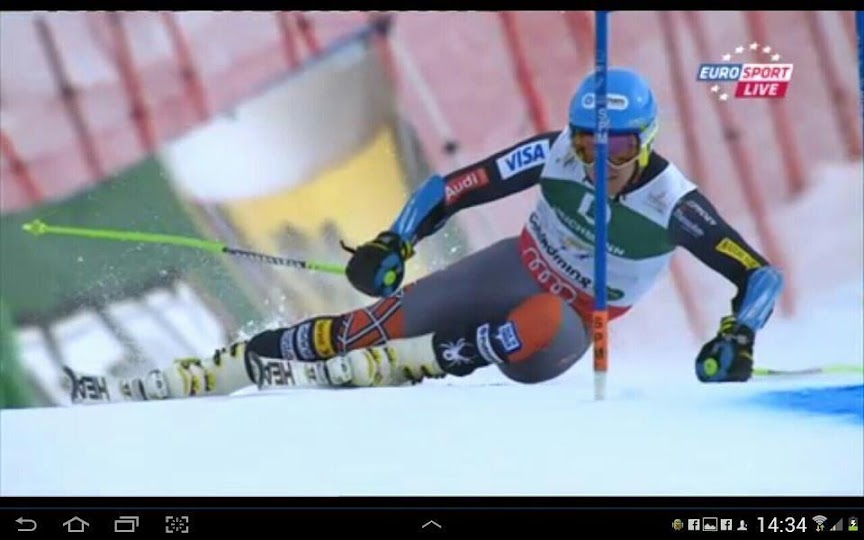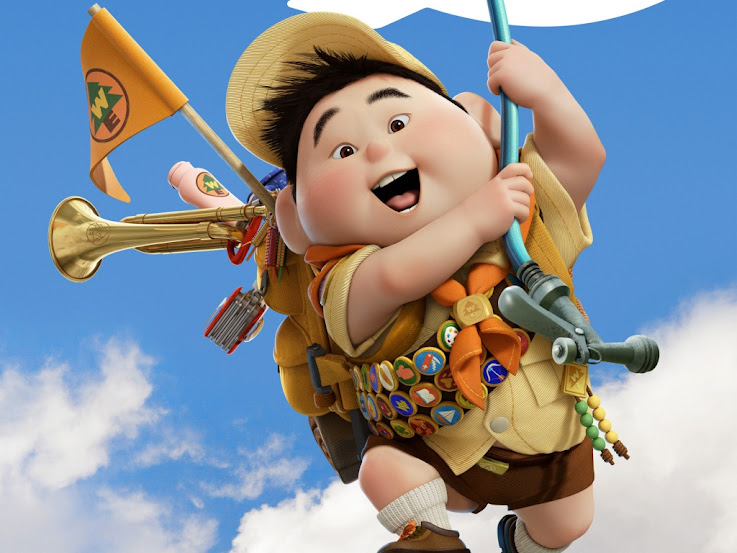Well, you can either spend your life confined to the pistes cultivating your snowplough and balance or you can do it like this…
Off Piste
The boys were wearing avalanche transceivers because we had at least 30cm of fresh snow at altitude and we were going to make use of it. With every section of deep snow the boys grew in both confidence and competence. The main goal was to be able to link turns rhythmically and to carry some speed without the threat of being overpowered by the skis. We had of course worked all week on building awareness of the physical dynamics and the emotions involved but it was interesting to see if this had prepared them to adapt to serious Off Piste. The first run started on a short very steep section. I didn’t give them time to think so that they wouldn’t even entertain the idea of fear. Max had to ski first to a designated point and then Mark. I had to stay uphill in case either of them wiped out and lost their skis. It can be a real struggle to find skis lost in deep powder and sometimes people spend hours stuck there searching. After only a few sections it was clear that both the boys were very solid on their skis and were on a positive learning curve. This development permitted me to take the risk of skiing ahead to show the route and to film better from below. On each section there would be some minor feedback and modification. One of the best things Max did was to ski in my tracks on a steep section. I hadn’t intended for him to do that but in the space of a few dozen turns he understood the rhythm – and of course Mark didn’t miss this development either.
Despite the slopes being steep and bumpy underneath the fresh snow the boys didn’t have a single wipe-out all morning. Something else important needs to be mentioned: They were not using Off-Piste skis! They were on short, narrow carving slalom skis. This proves that technique is the key to everything. For many years I always skied on short slalom skis Off-Piste and only changed to wide all-mountain skis when technology eventually evolved in some specifically interesting directions. The fact is however that wide skis are too forgiving for learning – allowing bad skiers to ski almost anywhere. The boys in contrast remained standing only because they were skiing well.
We did two serious Off-Piste descents in the Solaise - Le Manchet sector then headed up the Olympic lift to the Bellevarde sector by 11am – at which point the weather changed with cloud and snow arriving and loss of visibility. The weather window had been perfect for us and so we went into a café for some refreshments. Only the boy’s competence and courage had made the adventure successful and to be honest they were both impressive. Today they became real skiers.
On Le Manchet chairlift the boys asked me a question: “If you could meet anyone in the world who would you chose?”. My answer was “My first serious girlfriend”. I explained that the first time you fall in love is special and some part of it stays with you for life. Mark then made one of his inimitable observations “The rest are just Hillbillies!”. If Max grows up to be a lawyer then Mark will surely grow up to be a philosopher or artist. Max is very logical and seems concerned with reasoning and working things out. Mark goes with the flow – and was singing to himself most of the time when skiing. I couldn’t understand his rapping though.
Jumping
One last airbag jump each was in order and the goal was to try to jump at take off to increase the height. I’m not sure the take-off ramp is well shaped for that though being a bit of a “kicker”. Mark got half way up the runway and gave up due to the difficulty of climbing with skis on. I obliged him to continue to climb slowly and not to give up. He needs to learn that when confronted with a task like that then little steps and persistence gets you there. This is where his impulsiveness works against him!
Mark did request more jumping later on but it was important to use our afternoon (and the bad weather) for working on technique.
Slalom
Max desperately wanted to knock off two tenths of a second from his slalom record to get into the qualified racing categories – but due to the bad weather the slalom course was not reset for the afternoon so it was in bad condition. Despite three brave attempts Max remained a fraction of a second off the time – but he improved his dynamics and just coping with a rutted course like that would have been impossible for him even a day or two earlier. I explained that the time he was going for wasn’t an issue – the important thing was that his skiing was improving and I was able to see from the slalom what we needed to work on next. The main area to develop now for both Max and Mark is the timing and range of motion of the legs. Both boys are relatively rigid. Although the deep snow and dynamics had made both of them bend in response to the forces involved they now had to generate some of this leg activity consciously. Slalom is on a hard surface and this tends to make people react by becoming more rigid through bracing and resisting. Max was clearly now letting the skis run forwards (instead of throwing them sideways) and using them as a platform to move his centre of mass – but this is still only the beginning of his skiing development.
Short Swings
One of the exercises to begin to get the legs working is “Short Swings”. This is essentially a pivot with the turn transition carried out in the air from a jump. First of all we had to work a little on static jumping. Mark had trouble getting off the ground at all but both of the boys jumped with a heel retraction to get the skis up. The jump should fully extend the legs when in the air – landing with straight legs and then bending to absorb the landing. We didn’t spend a lot of time on this. Both boys were familiar with Pivoting – the pulling/swinging of the airborne ski tips inwards over a Mogul – so the instruction was to jump up and do the same. They both managed reasonable Short Swings after a few attempts.
Poles
During the week my only mention of ski poles had been to avoid wearing the straps and not to throw the poles away during a fall. For a short while Mark had to wear the straps because he was throwing his poles away every few minutes – but this phase was rapidly left behind. Straps are never worn near ski lifts or Off Piste (for safety reasons) and in reality they are just not needed when skiing. Pole “Planting”is fairly critical in any Pivoting (braking) skiing (Moguls, Short Swings, Steeps etc.) – but Pole Planting does not occur in flowing skiing – which is why I have hardly mentioned the poles all week. I did mention and demonstrate Pole Planting with the Pivoting in Moguls but deliberately didn’t focus on this as the boys seemed to understand and copy reasonably well. There are issues of “Hip Angulation” involved with pole use and more complex aspects of coordination that would only have served to confuse the boys. They did incredibly well without any of this complication. Watching them skiing the deep Off-Piste without even using their poles (Pole Touch for flowing skiing) is very interesting. They get away with this partly due to low body weight and the combination of deep snow and air resistance dampening the accelerations.
Heavier (adults) people accelerate more due to pushing through the air and snow with less resistance. Body volume (mass) increases by its cube whereas surface area increases by its square – so bigger people are much less affected by air resistance. Children suffer from cold more easily for exactly the same reason – they have a greater surface area relative to their body mass.
Without pole planting being introduced the boys would be limited in their Short Swing ability – but there was no time to work on that and the objective was just to get the legs active – as opposed to being only reactive.
Skating
Once the legs were moving it was time to get back to skating exercises and see if we could move further forwards with this. Neither of the boys had previously managed to integrate the skating properly into their skiing because there were too many opposing movements already in their skiing. All week we had worked on replacing those other movements so it would interesting to see if a skating action could now be developed. Max’s first attempts were still affected by him switching from initially skating to pushing his skis sideways to try to turn them – but this time he was able to sense the difference when brought to his attention. Both Max and Mark then managed to skate their turns – moving the body (Centre of mass) instead of pushing their feet away. This can be seen in the video as a distinct skating “Down/Up” timing in sync with the “Down/Up” timing of the dynamics. The goal is to establish a resonance through using the legs. Max in particular had already managed this resonance in the deep snow when the forces involved imposed it upon him due to getting his body in the right place – but now the goal was to develop this sensation through actively bringing it to life with the legs on hard ground.
Visibility
During the afternoon the visibility and light dropped so that is was impossible to distinguish any physical relief even on the piste. Mark responded by slowing down to a crawl at one point. I told him to stop staring at the void in front of him and to look at me instead for his cue. He caught on quickly. It’s also important to know that when you can’t see then you have to learn to focus on feeling instead because being over attentive to vision actually causes you to tense up and become unable to respond reflexively to surprises. You have to work at “not looking” and concentrating instead on sensations from the feet and relative positioning of body parts (Proprioception) in motion. When you do this correctly it’s extremely rare that you actually experience a problem that the reflexes fail to cope with – even Off Piste in a White-Out – as long as you generally know the terrain.
Conclusion (Centring)
The boys did amazingly well in every respect – but the video and photos are all that’s really necessary to make that clear. One thing to bear in mind in future is the negative effect of poor teaching. Max’s perplexing problem – which we overcame – was not his fault but was produced by the effect of very inappropriate training. Max’s inability to perceive my instructions should be a warning as to how we all easily become rigid products of brainwashing that disconnects us from ourselves and reality. Mark’s different thinking processes probably permit him to circumvent those issues more easily just by being more centred. Max gradually became more focussed on moving his Centre of Mass. All body movement should be from the centre outwards and attention should be focused on that centre. Strangely, the mental and emotional centring are linked directly to the physical aspect.


